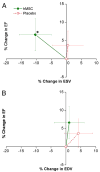Translational findings from cardiovascular stem cell research
- PMID: 22940024
- PMCID: PMC3563254
- DOI: 10.1016/j.tcm.2012.05.017
Translational findings from cardiovascular stem cell research
Abstract
The possibility of using stem cells to regenerate damaged myocardium has been actively investigated since the late 1990s. Consistent with the traditional view that the heart is a "postmitotic" organ that possesses minimal capacity for self-repair, much of the preclinical and clinical work has focused exclusively on introducing stem cells into the heart, with the hope of differentiation of these cells into functioning cardiomyocytes. This approach is ongoing and retains promise but to date has yielded inconsistent successes. More recently, it has become widely appreciated that the heart possesses endogenous repair mechanisms that, if adequately stimulated, might regenerate damaged cardiac tissue from in situ cardiac stem cells. Accordingly, much recent work has focused on engaging and enhancing endogenous cardiac repair mechanisms. This article reviews the literature on stem cell-based myocardial regeneration, placing emphasis on the mutually enriching interaction between basic and clinical research.
Copyright © 2012 Elsevier Inc. All rights reserved.
Figures



References
-
- Amado LC, Saliaris AP, Schuleri KH, et al. Cardiac repair with intramyocardial injection of allogeneic mesenchymal stem cells after myocardial infarction. Proceedings of the National Academy of Sciences of the United States of America. 2005;102(32):11474–11479. doi: 10.1073/pnas.0504388102. Comparative StudyResearch Support, N.I.H., ExtramuralResearch Support, Non-U.S. Gov’t. - DOI - PMC - PubMed
-
- Assmus B, Rolf A, Erbs S, et al. Clinical outcome 2 years after intracoronary administration of bone marrow-derived progenitor cells in acute myocardial infarction. Circulation Heart failure. 2010a;3(1):89–96. doi: 10.1161/CIRCHEARTFAILURE.108.843243. Multicenter StudyRandomized Controlled Trial Research Support, Non-U.S. Gov’t. - DOI - PubMed
Publication types
MeSH terms
Grants and funding
LinkOut - more resources
Full Text Sources
Medical

